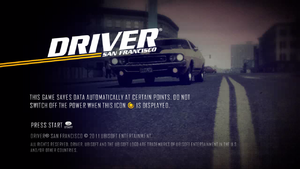User:Pivotman319/Sandbox
This is a sub-page of User:Pivotman319.
The FPP Gameplay Builds are two of the earliest available Driver: San Francisco builds, being compiled several hours apart from each other on 25 September 2008. They represent a functional state of the game that is otherwise rather close to the final release, save for the absence of garages, vehicle damage, challenges and activities (such as dares). Much of the existing functionality from the final release is otherwise present in the two builds, respectively named Gym_Oliv and SessionList.
Most (if not all) of the existing game visuals at this point in development are merely placeholders or assets reused from other games, such as Driver: Parallel Lines. The XEX metadata for the two builds (as well as within the later pre-production update build and in builds compiled during January/February 2011) unusually refers to this game as Dark Messiah of Might and Magic, the Xbox 360 port of which is not developed by Ubisoft Reflections, but rather by a different Ubisoft-owned studio, despite carrying a unique Xbox title ID. The game is internally codenamed Driver NextGen, or just DriverNG in short - said name would be used throughout the entirety of Driver: SF's development lifespan.
Core gameplay
Gameplay is otherwise mostly similar to the final release of Driver: San Francisco. A player may Shift/"zap" into any vehicle as they desire by pressing the triangle action button on the player's controller. Individual missions (referred to as Lives) are accompanied by a specific goal, such as scoring points (a feature that is not present in late development builds), damaging enemy vehicles, outrunning the police, or completing sprint races by passing through checkpoints.
Depending on the player's overall score or performance during a Life, a player may be able to unlock special abilities (referred to as Incentives) such as speed boosts, ramming into other vehicles or tilting the player's car into an ajar angle to narrowly avoid oncoming traffic. Unlike the final release, abilities are tied to specific vehicles, and are not shared across all vehicles driven by the player. There is only one storyboard present in the two builds, which correlate to a taxi mission that involves needing to scare a passenger by scoring enough points; the general mission theme of which would eventually evolve in the final game release in the form of a playable activity and two in-game story missions that require the player to reach or maintain a specific heartbeat rate by constantly performing vehicle tricks.
A mission can be played with another player; the game will wait for another player to join the networked session by default unless the player opts to play the mission by themselves. Changing network options once the level is loaded does not appear to have any influence on how the multiplayer party system works.
Miscellaneous functionality
The game boots into a debug configuration menu by default, allowing the developer to set the current level, vehicle, and network configuration options. The second-former option does not appear to function at all, as the game will not automatically grant the player's desired vehicle once the level is loaded into.
An additional development menu may be brought up by pressing the two analog thumb sticks on the player's controller, exposing a small set of options which may be used to debug multiplayer networking functionality and display verbose output for in-game events, such as traffic data and the overall number of vehicles present in the game world.
Development levels
Most levels in the two builds are not accessible as they either soft-lock the game or trigger an engine crash. The only accessible levels are "Gym City" (with and without requiring progression; a very early rough blockout of San Francisco) and the Model Previewer, the latter of which crashes the game if attempting to view an existing model by changing view modes.
